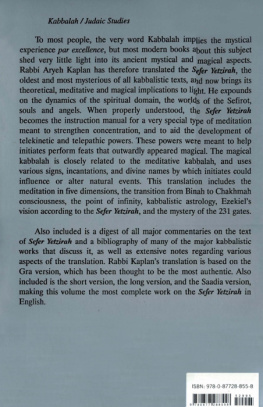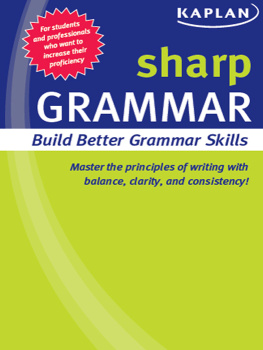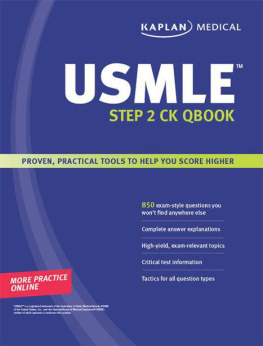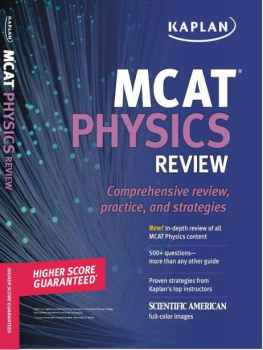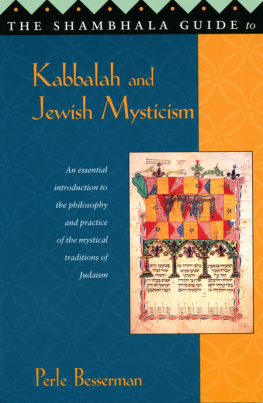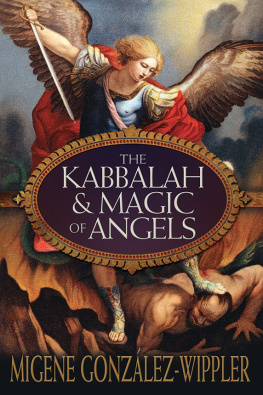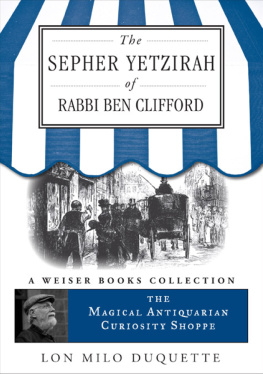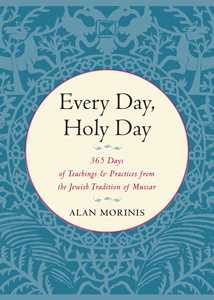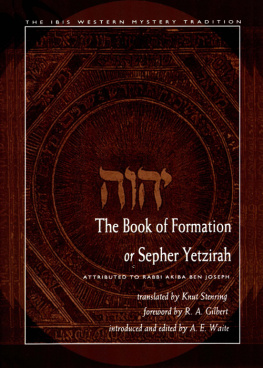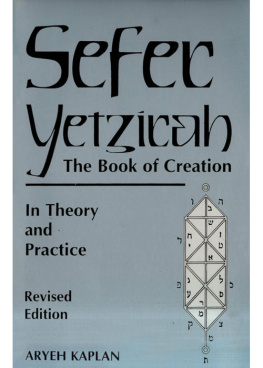
Revised edition published in 1997 by
Red Wheel/Weiser, LLC
With offices at
500 Third Street, Suite 230
San Francisco, CA 94107
www.redwheelweiser.com
An index has been added to this corrected edition
Copyright 1997 The Estate of Aryeh Kalpan
All rights reserved. No part of this publication may be reproduced or transmitted in any form or by any means, electronic or mechanical. including photocopying, recording, or by any information storage and retrieval system, without permission in writing from Red Wheel/Weiser, LLC. Reviewers may quote brief passages. Original edition copyright 1990 The Estate of Aryeh Kalpan.
ISBN: 978-0-87728-855-8
Library of Congress Cataloging-in-Publication Data
Sefer Yetzirah, English & Hebrew.
Sefer Yetzirah = The Book of Creation: in theory and practice / Aryeh Kaplan.Rev. ed.
p. cm.
Inculdes bibliographical information and index.
ISBN 0-87728-855-0 (pbk.: alk. paper)
1. CabalaEarly works to 1800. 2. Sefer Yetzirah. I. Kaplan, Aryeh 1934-1982 or 3. II. Title.
BM525.A412K37 1997
296.1'6dc21
96-49121
Cover design by Michael Martin
Typeset in Times
Printed in the United States of America
EB
15 14 13 12
The paper used in this publication meets the minimum requriments of the American National Standard for Information Science-Permanence of Paper for Printed Library Materials Z39.48-1992 (R1997).
www.redwheelweiser.com
www.redwheelweiser.com/newsletter
About the Translator
Rabbi Aryeh Kaplan was a world-renowned Torah scholar who produced over 50 books in his brief lifetime, including Meditation and the Bible, Meditation and Kabbalah and The Bahir. Kaplan's works encompassed commentary and translation of ancient and obscure works by Bible scholars and Kabbalists. and works advising young Jews on the merits of study and observance. For a while he was an editor of Jewish Life magazine, translated an enormous commentary on the Torah by the Sephardic rabbi, Yaakov Culi, and produced an original translation-commentary of the Five Books of Moses, which he called The Living Torah, published by Moznaim, Israel.
Aryeh Kaplan was born in the Bronx, studied at local yeshivot, and continued his education at yeshivot in Israel. For a while he entered the field of science and was, for a brief period, the youngest physicist employed by the United States government before devoting his life to Torah scholarship. He died at the age of 48 in 1983.
CONTENTS
APPENDIXES
Introduction
The Sefer Yetzirah is without question the oldest and most mysterious of all Kabbalistic texts. The first commentaries on this book were written in the 10th century, and the text itself is quoted as early as the sixth. References to the work appear in the first century, while traditions regarding its use attest to its existence even in Biblical times. So ancient is this book that its origins are no longer accessable to historians. We are totally dependent on traditions with regard to its authorship.
Equally mysterious is the meaning of this book. If the author meant to be obscure, he was eminently successful. It is only through the most careful analysis, studying every word with its parallels in Biblical and Talmudic literature, that its haze of obscurity begins to be penetrated.
There have been many interpretations of the Sefer Yetzirah. The earliest commentators tried to interpret it as a philosophical treatise, but their efforts shed more light on their own systems than on the text. The same is true of efforts to fit it into the systems of the Zohar or later Kabbalists. Efforts to view it as a book on grammar or phonetics are even more unsuccessful.
In general, the Kabbalah is divided into three categories, the theoretical, the meditative, and the magical. The theoretical Kabbalah, which in its present form is based largely on the Zohar, is concerned mostly with the dynamics of the spiritual domain, especially the worlds of the Sefirot, souls and angels. This branch of Kabbalah reached its zenith in the writings of the Safed school in the 16th century, and the vast majority of published texts belong in this category.
Meditative Kabbalah deals with the use of divine names, letter permutations, and similar methods to reach higher states of consciousness, and as such, comprises a kind of yoga. Most of the main texts have never been published, but remain scattered in manuscripts in the great libraries and museums. Some of these methods enjoyed a brief renaissance in the mid 1700's with the rise of the Hasidic movement, but within a half century they were once again largely forgotten.
The third category of Kabbalah-the magical-is closely related to the meditative. It consists of various signs, incantations and divine names, through which one can influence or alter natural events. Many of the techniques closely resemble meditative methods, and their success may depend on their ability to induce mental states where telekinetic or spiritual power can effectively be channeled. As with the second category, the most important texts have never been printed, although some fragments have been published. One of the best examples of these is the book Raziel.
Careful study indicates that Sefer Yetzirah is a meditative text, with strong magical overtones. This position is supported by the earliest Talmudic traditions, which indicate that it could be used to create living creatures. Especially significant are the many reports and legends in which the Sefer Yetzirah is used to create a Golem, a sort of mystical android.
The methods of the Sefer Yetzirah appear to involve meditation; and it is highly possible that it was originally written as a meditative manual. A major 12th century philosopher thus states that it does not contain philosophy, but divine mystery. This comes across very clearly in the commentary of one of the greatest Kabbalists, Isaac the Blind (11601236), who stresses the meditative aspects of the text.
It is also particularly evident in a very ancient manuscript of Sefer Yetzirah, dating from the 10th century or earlier. The introductory colophon states, This is the book of the Letters of Abraham our father, which is called Sefer Yetzirah, and when one gazes (tzafah) into it, there is no limit to his wisdom. As we shall discuss in our commentary (on 1:6), the Hebrew word tzafah does not denote mere physical gazing, but mystical meditative insight. This very early source would therefore support the position that Sefer Yetzirah was meant to be used as a meditative text.
The commentaries which treat Sefer Yetzirah as a theoretical text, read much of it in the third person: He combined, He formed, and the like. According to this reading, the text is referring to God's creation. In many cases, however, the grammatical form more closely resembles the imperative.the implications of such a reading are discussed in the commentary.
What we therefore have in Sefer Yetzirah appears to be an instructional manual, describing certain meditative exercises. There is some evidence that these exercises were meant to strengthen the initiate's concentration, and were particularly helpful in the development of telekinetic and telepathic powers. It was with these powers that one would then be able to perform feats that outwardly appeared to be magical. This is supported by the Talmudical references, which appear to compare the use of Sefer Yetzirah to a kind of white magic.
The Text
The Sefer Yetzirah is a very small and concise book. In its Short Version, it is only some 1300 words long, while the Long Version contains approximately 2500 words. The Gra Version used in this translation contains around 1800 words. So short is the text, that one of the earliest fragments appears to have the entire book written on a single page.
Next page
